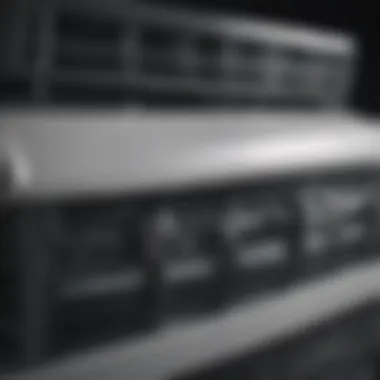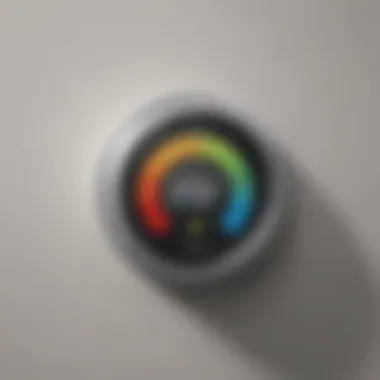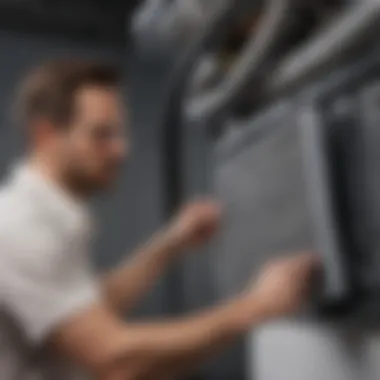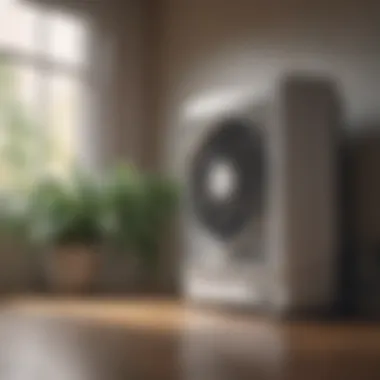Troubleshooting Air Conditioner Cooling Problems


Intro
Experiencing insufficient cooling from your air conditioning system can be frustrating. Many homeowners face this challenge during warmer months, only to discover that their unit is simply blowing air without providing the comfort they seek. This article delves into the reasons behind insufficient cooling despite strong airflow and offers a structured way to diagnose and resolve these issues. It will empower you with knowledge, enabling you to troubleshoot effectively and enhance the comfort of your living environment without relying heavily on professional services.
Identifying the Problem
Understanding the nature of your air conditioning issue is the first step. Several reasons may contribute to airflow without cooling. For example, the unit may be low on refrigerant, the thermostat settings may be incorrect, or there could be blockages within the system.
- Refrigerant Levels: Low refrigerant can prevent the airflow from cooling properly.
- Thermostat Settings: Incorrect settings may mislead users into believing the system is not functioning.
- Air Filters: Dirty or clogged air filters restrict airflow, reducing the unit's efficiency.
- Compressor Issues: If the compressor is malfunctioning, the unit may fail to cool even though it runs.
Step-by-step Diagnostics
Diagnosing the precise cause requires a systematic approach:
- Check Thermostat Settings: Ensure that the thermostat is set to a lower temperature than the current room temperature. This simple check can often clarify if the system is operating correctly.
- Inspect Air Filters: Look at the air filters and clean or replace them if they are dirty. Clogged filters are a common issue.
- Examine Refrigerant Levels: If comfortable, inspect the refrigerant levels. This task may require professional assistance since handling refrigerants can be complex and regulated.
- Evaluate the Outdoor Unit: Ensure that the outdoor condenser coils aren’t blocked by debris, plants, or dirt. Keeping the area clean promotes efficiency.
- Listen for Odd Noises: Sounds from the unit can indicate malfunction. If the compressor is making unusual noise, this may suggest serious issues.
"Maintaining your air conditioning unit is not just about comfort. It’s about ensuring functionality and longevity of the system."
Strategies for Resolution
Once you identify the underlying issue, addressing it becomes much easier:
- Refrigerant Recharge: If you find low refrigerant, have a professional recharge it and look for leaks.
- Reset the Thermostat: Sometimes, simply resetting the thermostat can rectify any minor glitches.
- Replace Air Filters Regularly: Schedule monthly checks of air filters and replace them when necessary.
- Professional Maintenance: Consider scheduling annual maintenance with a qualified technician to avoid future problems and ensure your unit runs smoothly.
By following these diagnostic and resolution strategies, homeowners can address the challenge of insufficient cooling and maintain a comfortable environment.
The next section will discuss common misconceptions about air conditioning systems and clarify them to help equip you with more effective insights for handling your cooling needs.
Understanding Air Conditioner Basics
Understanding how air conditioners work is fundamental for any homeowner or renter experiencing cooling issues. Knowledge of basic principles aids in recognizing when your system is not functioning properly. Moreover, it allows for informed decision-making about repairs and maintenance, facilitating a more comfortable living environment.
How Air Conditioners Function
Air conditioning systems utilize the principles of thermodynamics to cool indoor spaces. The core concept involves the transfer of heat from the indoors to the outdoors. The refrigerant, a special fluid, plays a crucial role in this process.
- Evaporation: Inside the evaporator coil, the refrigerant absorbs heat from indoor air, causing it to evaporate into gas.
- Compression: The gaseous refrigerant is then compressed by the compressor, raising its temperature.
- Condensation: The hot gas travels to the condenser coil, where it releases heat to the outside air and condenses back into a liquid.
- Expansion: This liquid refrigerant expands through a valve, cooling it before it re-enters the evaporator.
This cycle repeats as long as the air conditioner is operational, maintaining a comfortable indoor climate.
Components of an Air Conditioning System
Every air conditioning system comprises several key components, each contributing to its overall operation. Recognizing these components can help identify potential faults when the unit malfunctions.
- Evaporator Coil: Responsible for absorbing heat indoors. If it's dirty, it hinders cooling efficiency.
- Compressor: It pumps the refrigerant through the system. A failed compressor means no heat transfer.
- Condenser Coil: This dissipates heat to the outside environment. Blocked coils lead to inadequate cooling.
- Expansion Valve: Regulates refrigerant flow into the evaporator. Faults can disrupt the cooling cycle.
- Air Filters: These capture dust and debris. Clogged filters impede airflow, decreasing efficiency.
Understanding these elements will not only aid in diagnosing issues but also in recognizing best practices to maintain optimal performance.
Identifying the Problem: Air Conditioner Blowing Air without Cooling
Understanding why an air conditioner can blow air without providing adequate cooling is essential for maintaining a comfortable home environment. This issue can lead to discomfort and increased energy costs, and delaying repairs can escalate the problem. Identifying the root causes early allows homeowners to address these concerns effectively, potentially avoiding costly professional repairs. By discussing symptoms and common mistakes associated with air conditioning use, this article sheds light on the vital first steps in troubleshooting insufficient cooling.
Symptoms of Insufficient Cooling
Recognizing the specific symptoms associated with insufficient cooling is crucial for accurate diagnosis. Common indicators include:
- Warm Air Flow: When the air conditioner runs but only warm air circulates, it is a clear sign of a problem.
- Humidity Levels: High humidity indoors can imply that cooling is not occurring effectively, even if the air conditioning system appears operational.
- Inconsistent Temperatures: Some areas of the home remain cooler than others, indicating uneven cooling.
- Frequent Cycling: If the unit constantly turns on and off without reaching the desired temperature, there may be an underlying issue.
Understanding these symptoms helps narrow down potential solutions and informs whether a deeper inspection is needed. It's essential to monitor these indicators consistently to maintain comfort levels.


Common Mistakes in Air Conditioning Use
Homeowners often unknowingly commit mistakes that impact their air conditioning's performance. Recognizing these can lead to successful troubleshooting:
- Ignoring Regular Maintenance: Skipping routine maintenance like changing filters can clog the system, leading to insufficient cooling.
- Setting the Thermostat Incorrectly: Leaving the thermostat set to a higher temperature than necessary can prevent the air conditioner from cooling efficiently.
- Obstructing Vents: Blocking air vents with furniture or décor restricts airflow, negatively affecting cooling.
- Overloading the System: Running large appliances or creating excess heat indoors can impede an air conditioner's performance, leading to inadequate cooling.
Being aware of these common errors empowers homeowners to take corrective actions, potentially restoring the efficiency of their air conditioning system.
Potential Causes of Limited Cooling
Understanding the potential causes of limited cooling is crucial for diagnosing air conditioning problems effectively. When an air conditioner blows air without providing adequate cooling, it can significantly impact comfort levels at home. Identifying the root cause helps homeowners make informed decisions, whether that means troubleshooting on their own or seeking professional assistance. This section delves into various factors that can lead to insufficient cooling, each of which warrants careful consideration.
Dirty Air Filters
Dirty air filters are often one of the first culprits in inadequate cooling. Filters trap dust, pollen, and other particles to maintain clean air circulations. Over time, these filters can become clogged, restricting airflow through the system. The airflow drops, causing the system to work harder. This strain can result in higher energy consumption and extended cooling times. Checking and cleaning or replacing air filters regularly can significantly improve the efficiency and performance of the air conditioning system.
Refrigerant Issues
Refrigerant plays a vital role in the cooling process. If there is a leak or shortfall of refrigerant, the air conditioning system cannot effectively absorb heat from the indoor air. Symptoms of refrigerant issues often include hissing noises or ice forming on the coils. Homeowners may notice that their air conditioner's performance declines suddenly. Addressing refrigerant levels typically requires the expertise of a qualified technician, as they can identify leaks and ensure proper charging of the system to restore optimal function.
Faulty Thermostat Settings
A thermostat's settings directly influence the temperature of the air produced by an air conditioning unit. If the settings are incorrect, say, the thermostat is set too high, the system may not cool the space effectively. Additionally, malfunctioning thermostats may give faulty readings, leading to inadequate cooling actions. Regularly verifying the settings and possibly recalibrating the thermostat can ensure optimal performance and comfort in the living space.
Issues with the Condenser Unit
The condenser unit plays a pivotal role in dissipating heat absorbed from inside the home. If it is dirty, obstructed, or malfunctioning, it cannot expel heat properly. This inefficiency may lead to insufficient cooling indoors. Regular cleaning and maintenance of the condenser unit are essential. Homeowners should check for debris around the unit and perform seasonal inspections. When problems arise, understanding condenser mechanics can help determine whether minor adjustments can be made or if professional assistance is necessary.
Obstructed Vents
Vents can easily become blocked by furniture, curtains, or other household objects. When airflow is obstructed, necessary air circulation diminishes, making it difficult for an air conditioner to maintain desired temperature levels. Homeowners should routinely inspect all vents to ensure they are unblocked and can freely circulate air throughout the space. As a simple step, moving or adjusting furniture can enhance overall efficiency and comfort.
Ductwork Problems
Ductwork is the framework that distributes conditioned air throughout your home. Issues such as leaks, poor connections, or damage can lead to significant air loss before it ever reaches the rooms. These problems often go unnoticed but can be detected through signs like uneven cooling or higher-than-usual energy bills. Inspecting ductwork for signs of wear, sealing leaks, and ensuring proper insulation are necessary for ensuring effective cooling from an air conditioning unit. Regular maintenance of ductwork often improves system efficiency and longevity.
Understanding these potential causes provides a foundation for tackling the issue of insufficient cooling in your air conditioning system effectively.
Diagnostic Steps to Take
To effectively address issues with an air conditioner that blows air yet provides insufficient cooling, it is crucial to implement a systematic approach to diagnostics. Each step serves as a foundational tool to uncover the precise source of the problem. Employing these steps allows homeowners to save time, reduce frustration and often avoid costly repairs. When one understands what to look for, diagnosing issues becomes a collaborative effort between the user and the equipment.
Visual Inspection of the Unit
Commencing with a visual inspection of the air conditioning unit is a simple yet essential step. This can reveal obvious problems, such as dirt accumulation or physical damage. Look for the following:
- Dirt and Debris: Ensure that the outdoor unit is free from leaves, soil, or any obstructive materials.
- Unusual Sounds: Listen for any odd noises during operation which may indicate mechanical issues.
- Leaking Fluid: Check for any signs of refrigerant leaks, which could point to significant underlying problems.
Conducting this initial inspection provides immediate insights and is a vital step before delving deeper.
Testing Thermostat Functionality
The thermostat plays a pivotal role in regulating temperature. If it is malfunctioning, the air conditioner may not operate as intended. To test it:
- Set the thermostat to a lower temperature than the current room temperature.
- Wait briefly and listen for the air conditioner to activate.
- Confirm if the airflow is cool representing functional cooling.
If no change occurs, the thermostat may need recalibration or replacement. It's essential to invest time in examining this component as it can lead to significant performance differences.
Checking the Air Filters
Air filters are often overlooked but are critical for effective air conditioning. A dirty filter can restrict airflow, leading to inadequate cooling. Follow these steps:


- Remove the air filter from its compartment and visually inspect it. If it appears clogged with dust or debris, it needs replacing or cleaning.
- Regularly replace filters, ideally every one to three months, to maintain optimal airflow.
- If unsure about the current state of the filter, replace it regardless, as it's an inexpensive and easy upkeep task.
Monitoring Refrigerant Levels
Refrigerant is essential for cooling air. Insufficient refrigerant levels can indicate a leak or undercharging during installation. To monitor:
- Access the service port on the refrigerant line.
- Use a pressure gauge to assess the levels against manufacturer specifications.
If levels are low, professional help will typically be needed to recharge the refrigerant. This step is crucial in ensuring the air conditioner provides optimal cooling potential.
Examining the Condenser Coils
The condenser coils release heat from the refrigerant. If they are dirty, the cooling performance is compromised. Here’s how to inspect:
- Turn off the power to the unit.
- Remove any debris or dust clinging to the coils using a soft brush or cloth.
- Consider using a coil cleaner spray if they appear significantly dirty.
Maintaining clean coils is essential for efficient system operation. Regular checks can help mitigate issues before they worsen.
By following these diagnostic steps, homeowners can identify and potentially rectify common problems associated with air conditioners that fail to cool effectively despite airflow. Each action taken during these diagnostic procedures contributes to a clearer understanding of the unit's health and functionality.
Practical Solutions and Troubleshooting
Practical solutions and troubleshooting are vital to address insufficient cooling from an air conditioner that is blowing air. When airflow is present but cooling is not effective, these focused strategies provide ways for homeowners to restore comfort in their living spaces. Understanding these solutions can empower individuals to take actionable steps without always needing to rely on professional services. Thus, improving overall efficiency and reducing long-term costs associated with HVAC systems.
Cleaning or Replacing Air Filters
Air filters play a crucial role in maintaining efficient airflow and optimal cooling. Over time, filters can accumulate dirt and debris, which restricts air volume and adversely affects cooling. Regularly cleaning or replacing air filters, ideally every 1-3 months, ensures that cool air flows freely throughout your home.
- Signs of a dirty filter include:
- Decreased airflow
- Increased energy bills
- Unusual odors from vents
Cleaning reusable filters is simple: remove them from the unit, wash with water, and allow them to dry completely before reinserting. Non-reusable filters should be replaced with a new one that matches the manufacturer's specifications. Ignoring filters results in inadequate cooling and can even lead to more extensive HVAC problems.
Adjusting Thermostat Settings
Thermostat settings directly affect how comfortably your home feels. A miscalibrated or incorrectly set thermostat can lead to situations where your air conditioning system runs but fails to cool effectively. Ensure that the thermostat is set to a temperature lower than the room temperature, and verify that it functions properly.
- Tips for optimizing your thermostat:
- Use programmable settings for efficiency
- Avoid placing the thermostat in direct sunlight or near heat sources
- Periodically check for errors in temperature reading
Adjusting the settings can lead to immediate improvements in cooling performance. A well-placed and properly set thermostat contributes significantly to your home's cooling efficiency.
Cleaning the Condenser Unit
The condenser unit is an essential component of the air conditioning system, located outside. If dirt and debris accumulate on the condenser coils, it can lead to ineffective heat exchange and insufficient cooling performance. Regular maintenance is necessary to keep this unit functioning efficiently.
- Cleaning involves these steps:
- Turn off the power to the unit
- Clear away leaves, dirt, and obstructions around the unit
- Use a soft brush or a hose to gently clean the fins of the condenser
Maintaining a clean condenser unit enhances airflow and promotes effective cooling, reducing the risk of breakdowns.
Sealing Duct Leaks
Leaky ducts can significantly undermine your air conditioner's ability to cool effectively. Air leaks from faulty ductwork lead to cool air escaping before it reaches intended spaces, resulting in uneven temperatures throughout the home.
- To address duct leaks:
- Inspect for visible tears or gaps in ductwork
- Utilize duct tape or mastic sealant for repairs
- Consider hiring a professional for an energy audit to identify less visible leaks


Properly sealed ducts ensure cool air travels directly to living spaces, enhancing overall comfort and energy efficiency in your home.
Regular maintenance of air conditioning systems is key to preventing issues, improving performance, and ensuring a consistently comfortable environment.
By implementing these practical solutions and focusing on troubleshooting, homeowners can resolve insufficient cooling issues effectively. Addressing these areas helps maintain a comfortable indoor climate, regardless of external temperatures.
When to Seek Professional Help
Air conditioning issues can often be intricate and layered in complexity. While homeowners can tackle some problems themselves, there are critical situations that demand the expertise of a professional. Recognizing these moments is vital to both the efficiency and longevity of the unit. In this section, we delve into the signs that suggest it's time to call for assistance, as well as how to choose the right HVAC technician for the job.
Signs Indicating Professional Intervention
There are specific symptoms indicating that an air conditioning system requires professional assistance. Understanding these signs can prevent further damage to the system and possibly save money in the long run. Here are some vital indicators to consider:
- Consistent Insufficient Cooling: If the air conditioner continues to blow air without cooling effectively despite attempts to resolve the issue, professional insight is likely needed.
- Strange or Loud Noises: Unusual sounds such as grinding, squealing, or banging can signal relaxed or broken parts that need specialized attention.
- Foul Odors: Any unpleasant smells, especially those that resemble burnt wiring, could indicate serious issues that require immediate investigation by a technician.
- Increased Energy Bills: A noticeable spike in energy costs without an increase in usage may hint at underlying issues with efficiency that a technician can assess.
- Frequent Cycling: If the air conditioner frequently turns on and off, it may cause wear on components, suggesting that a professional should assess the situation.
Professionals bring the expertise necessary to investigate these deeper issues, ensuring the unit functions optimally and safely.
Choosing the Right HVAC Technician
When it comes to selecting an HVAC technician, it is essential to make an informed choice. Not all technicians are created equal, and finding the right one can greatly affect the results of the service rendered. Here are guidelines to help choose wisely:
- Licensing and Certification: Ensure the technician is properly licensed and holds necessary certifications. This verifies that they have completed required training and adhere to industry standards.
- Experience and Specialization: Look for a technician with a history of working on your specific type of air conditioning unit. Specialization in brands or system types can make a difference in diagnosis and repair.
- Reviews and Recommendations: Check online reviews on platforms like Reddit or request recommendations from friends or family. Personal testimonials can provide valuable insights into reliability and service quality.
- Transparent Pricing: A trustworthy technician should provide clear estimates upfront, explaining the costs associated with parts and labor. Avoid technicians who give vague pricing or unclear explanations.
- Service Warranty: A reputable technician often stands by their work, offering warranties or guarantees for their services. This indicates confidence in their workmanship and provides peace of mind.
By paying attention to these factors, homeowners can find a capable technician who will efficiently address their air conditioning needs.
Preventative Maintenance Tips
Preventative maintenance is crucial for ensuring the efficiency and longevity of air conditioning systems. Regular upkeep helps in detecting potential problems before they escalate into major issues that require costly repairs. Moreover, maintaining the air conditioning unit contributes significantly to energy savings and sustained comfort in your living space.
Regular Cleaning and Replacing Filters
One of the simplest yet most effective measures is keeping air filters clean and replacing them when necessary. Dirty filters can restrict airflow, causing the system to work harder and eventually reduce its efficiency. This leads to inadequate cooling and higher energy bills. It is advisable to check filters monthly, especially during peak usage seasons. Depending on the type of filter, it might need changing every one to three months. A clean filter allows the system to circulate air freely, providing better cooling and improving indoor air quality.
Annual Professional Check-ups
Annual check-ups by a qualified technician are essential. During these appointments, professionals can conduct a comprehensive examination of the system. They check refrigerant levels, inspect coils, and examine electrical components for any signs of wear. These assessments can identify underlying issues that might not be apparent to the untrained eye. Scheduling regular professional maintenance can save money down the line by avoiding unexpected breakdowns in the middle of summer.
Keeping the Outdoor Unit Clear
The outdoor unit should be kept clear of debris such as leaves, branches, and dirt. This area is important for the unit's airflow and overall efficiency. Ensure there is at least two feet of clearance around the unit. Additionally, regular cleaning of the coils and removing any blockages can help optimize cooling performance. A clear outdoor unit facilitates better heat exchange, allowing the system to operate efficiently.
"Preventative maintenance not only prolongs the life of the system but also enhances its efficiency, safeguarding your investment in comfort."
Ending
In the context of this article, the conclusion serves as a critical summary of key information regarding air conditioning issues related to insufficient cooling. With the detailed exploration of causes, diagnostic steps, and troubleshooting solutions, readers can grasp the multifaceted nature of air conditioning problems. Understanding these factors ensures that homeowners are equipped with practical knowledge they need.
One significant element of the conclusion is the emphasis on awareness of air conditioner performance. Homeowners often overlook minor issues which may develop into larger problems if not addressed promptly. For instance, recognizing symptoms such as unusual noises or inconsistent airflow can lead to early intervention, saving both time and money.
Moreover, the conclusion underscores the value of routine checks and maintenance. Proactively managing your air conditioning system can enhance its lifespan and efficiency. Encouraging attention to these details not only ensures comfort but contributes to energy savings over time.
When discussing the benefits, readers should note that addressing cooling issues improves indoor air quality. This has lasting positive impacts on health and wellbeing, making maintenance a worthwhile investment. The final thoughts here serve to remind homeowners of the importance of vigilance and action regarding their air conditioning systems.
Recap of Key Points
To summarize the key points discussed in this article:
- Symptoms of Insufficient Cooling: Identifying signs like warm air and longer cooling cycles is critical.
- Common Causes: Dirty filters, inadequate refrigerant, or malfunctioning thermostats are principal offenders.
- Diagnostic Steps: Visual inspections, testing thermosats, and monitoring refrigerant levels can determine the issue.
- Practical Solutions: Routine filtering, cleaning the condenser unit, and sealing leaks are effective troubleshooting steps.
- Professional Help: Recognizing when to call technicians and selecting the right professional can help resolve complex issues.
- Preventative Maintenance: Regular cleaning and professional check-ups ensure prolonged system efficiency.
Understanding these points helps reinforce knowledge about handling air conditioning challenges.
Encouragement for Ongoing Maintenance
Continuing maintenance on your air conditioning system is essential. Regularly scheduled maintenance not only prolongs the life of the unit but also optimizes its overall performance. Homeowners should consider setting reminders for routine checks on filters and cleaning.
Engaging with an HVAC professional annually can diagnose potential problems before they escalate. This proactive approach to maintenance ensures that your air conditioning system runs smoothly when you need it the most. Moreover, keeping the outdoor unit clear of debris and ensuring adequate airflow are simple yet effective strategies that can save you from long-term issues.



